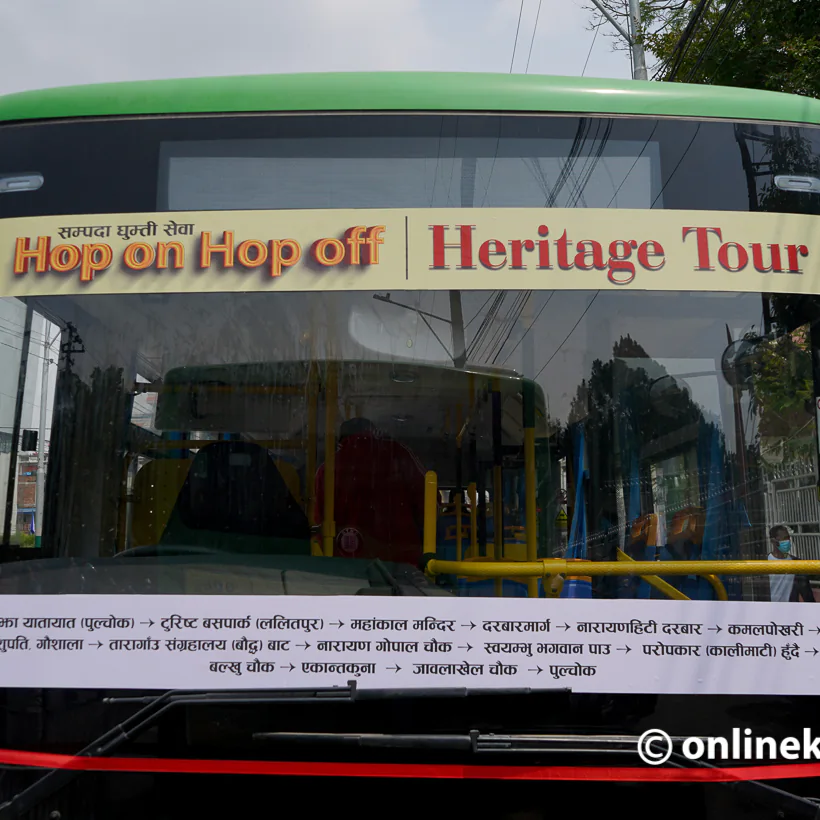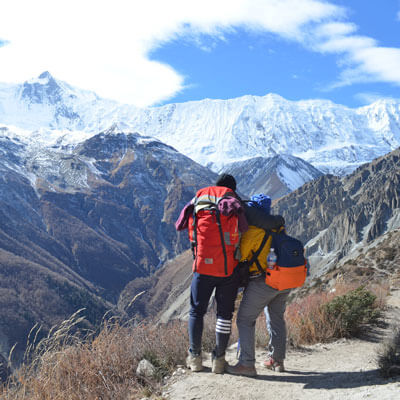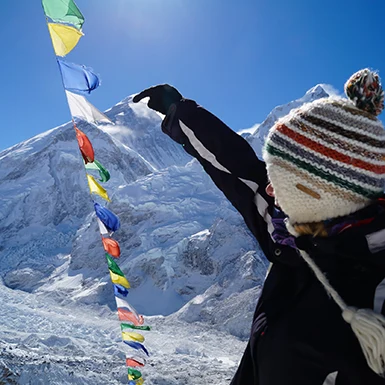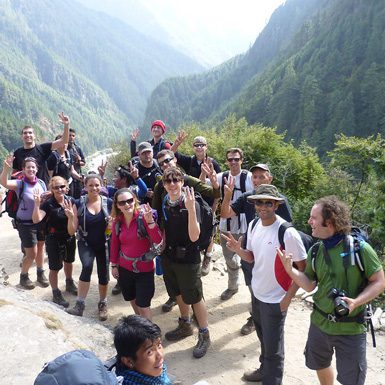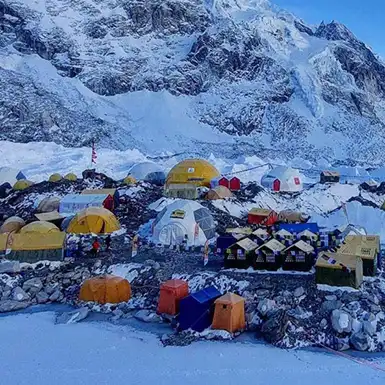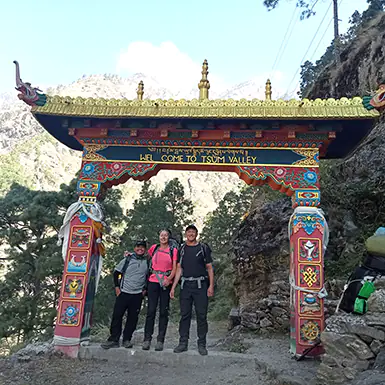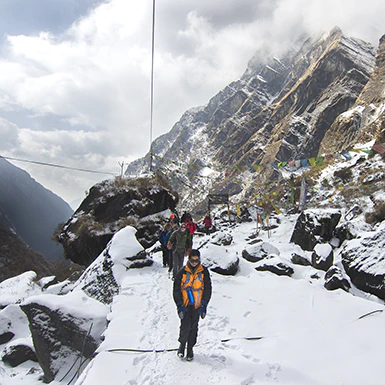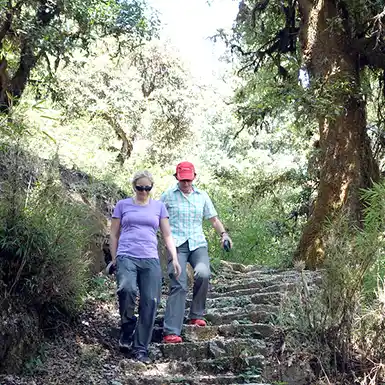Author: Admin
Annapurna Circuit Trek Permit and their Cost: A Complete Guide
Important Information on Annapurna Circuit Trek Permit
- ANCAP and TIMS Cards both are for a single entry.
- The permits are non-refundable and non-transferable.
- The validity of the permit is a maximum of 3 months.
- The price of the permits is the same regardless of how many days you are going.
- You must show your permits on all the counters along the trail. It is for your safety, so please do not fail to do this at each counter.
Conclusion
We trust that the information provided about the Annapurna Circuit Trek Permit has addressed any inquiries you may have had. Please get in touch with us if you have any additional questions or require further assistance regarding travel-related matters in Nepal. We are here to help.
[contact-form-7 id=”bec8616″ title=”Inquiry From – Blog”]
Trekking the Everest Base Camp
When to trek to Everest Base Camp?: Best time
Trekking in Nepal is possible throughout the year, as there are four distinct seasons, each offering unique attractions in different regions. The seasons are classified as follows:
Autumn (September to November)
Autumn, the post-monsoon season, is considered the best time to trek in Nepal’s Himalayan region due to its favorable weather conditions. This season offers stable weather with clear skies, providing trekkers with an unobstructed view of the majestic mountain ranges, making it an ideal time for photography.
The mild temperatures during the day and night make it comfortable for trekkers to embark on their journey. The season’s stable weather makes it easier to navigate the trekking routes, reducing the risk of encountering difficult weather conditions.
Autumn is also an ideal time to experience Nepalese culture and tradition. The Nepalese people celebrate various festivals during this time, including Dashain and Tihar. Trekkers can immerse themselves in the vibrant colors, music, and dancing on the streets of Kathmandu and Pokhara. Many temples and monuments hold special ceremonies and offerings, providing a cultural insight into Nepal’s history and tradition.
Moreover, Autumn is the best season for trekkers to fly into Lukla and Jomsom, two popular Nepal trekking destinations. The weather is stable during this season, ensuring a smooth and comfortable flight experience. Trekkers do not have to worry about unpredictable weather conditions leading to flight cancellations or delays during other seasons.
In conclusion, Autumn offers the perfect combination of favorable weather, breathtaking mountain views, and an opportunity to experience Nepalese culture and tradition, making it an ideal time to trek in Nepal.
Winter (December to February)
Winter in Nepal is considered the coldest and driest season, particularly in the higher elevations of the Himalayan region. This season is characterized by frequent snowfall and sub-zero temperatures, making trekking in the high passes challenging. However, it is also the best season for those who want to witness the beauty of snow-capped mountains and clear blue skies. The views of the mountain peaks during this season are breathtaking, and the landscapes are draped in snow, creating a serene and magical ambiance.
While high-altitude treks might not be advisable during winter, many lower-level treks can still be organized that offer panoramic views of the surrounding mountains. These treks are usually less crowded during winter, providing trekkers with a tranquil and peaceful environment.
Furthermore, winter is a perfect time to explore Nepal’s cultural and historical landmarks, particularly in Kathmandu and other cities. The streets come alive with festive decorations and lights during Christmas and New Year, offering an excellent opportunity to experience the festive spirit of Nepal.
In summary, while winter is not the most popular season for trekking in Nepal due to its challenging conditions, it is an ideal time for those who want to witness the beauty of snow-capped mountains and tranquil landscapes. Lower-level treks and cultural explorations provide a great alternative during this season.
Spring (March-May)
Spring is a delightful season for trekking in Nepal due to its pleasant climate, clear skies, and colorful landscape. The hills and valleys of Nepal come alive with blooming flowers such as rhododendrons and magnolias, creating a charming and enchanting atmosphere. The blooming flowers’ vibrant colors, lush green forests, and clear blue skies provide a picturesque view for trekkers to enjoy.
Spring weather is generally mild, making it comfortable for trekkers to explore and hike in the mountains. The temperature is neither hot nor cold, and the clear skies provide a stunning view of the mountains. The moderate daytime and cool temperatures at night make for a comfortable camping experience.
Spring is also an ideal time to visit the national parks in Nepal, as the wildlife is more active, and the flora is in full bloom. Nepal’s national parks are home to rare and exotic species like the snow leopard, red panda, and Himalayan musk deer, providing an excellent opportunity to experience Nepal’s unique wildlife and natural beauty.
In conclusion, spring is a beautiful and comfortable time to trek in Nepal, offering a colorful and enchanting landscape, mild temperatures, and clear skies. It is perfect for novice and experienced trekkers who want to explore the beauty and culture of Nepal.
Summer (June to August)
Summer in Nepal typically lasts from June to August and is characterized by hot and humid weather. While this season can be challenging for trekking in some regions of Nepal, it is still a great time to explore certain parts of the country. One of the significant advantages of trekking during the summer season is the lush greenery that covers the mountains, creating a stunning landscape for trekkers to enjoy.
However, the lower valleys can be rainy and muddy during this season, and it is challenging to walk on some trails. Additionally, the summer season is known for the presence of leeches in some regions, including the Annapurna region. These blood-sucking creatures can be a significant annoyance for trekkers. Still, experienced guides know how to deal with them by applying salt to walking boots and using other methods to keep them at bay.
Despite the challenges, the summer offers unique trekking opportunities and exploring Nepal. Many people choose to visit the high-altitude regions of Nepal during this season, where the weather is more pleasant. This is an ideal time to explore the stunning Himalayan landscape and trek to high mountain passes.
In conclusion, while summer can be a challenging season for trekking in Nepal due to its hot and humid weather and the presence of leeches, it still provides some unique opportunities for exploring the stunning landscapes of Nepal. Experienced guides can help trekkers manage these challenges and make the most of their experience in Nepal.
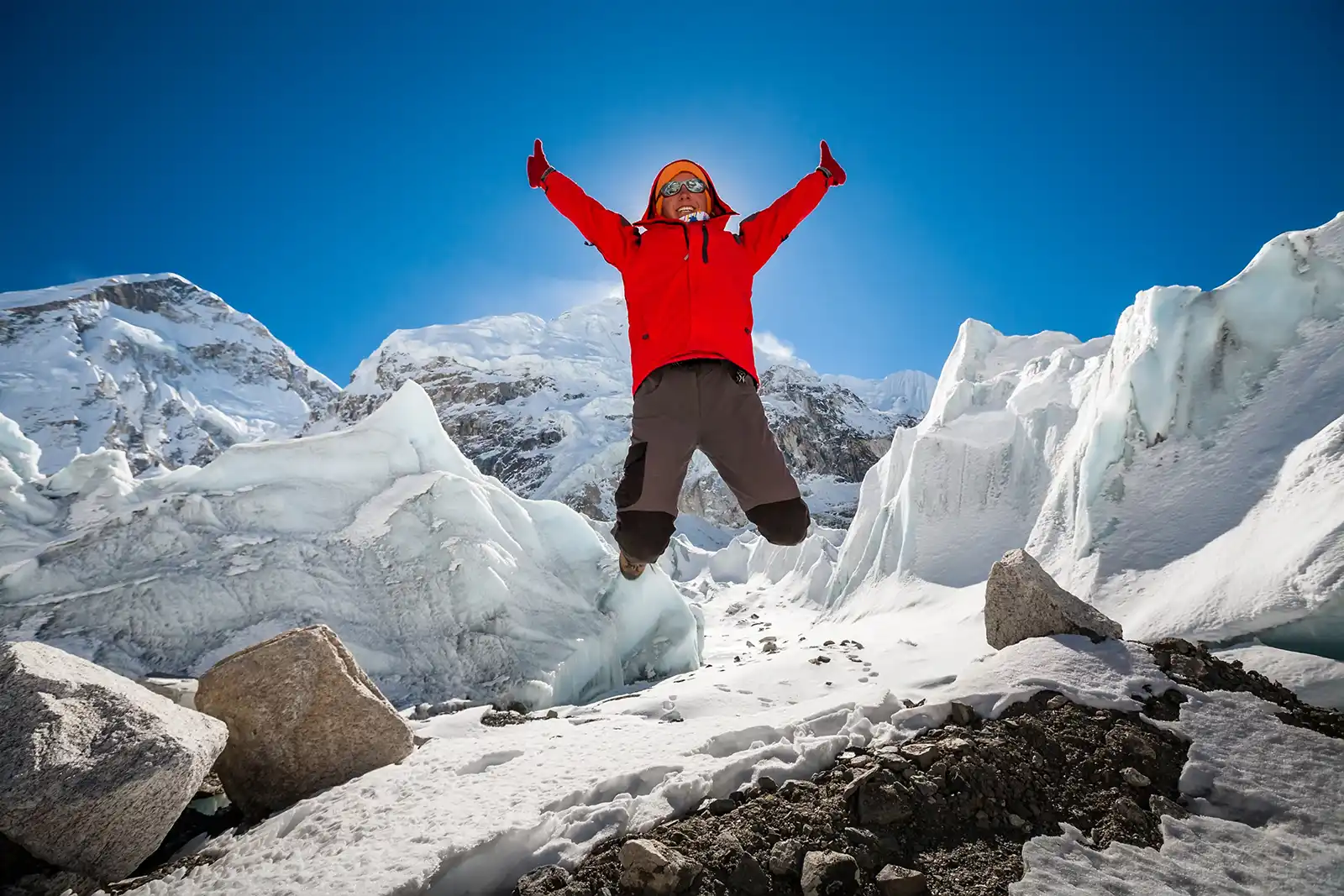
Also, See:
Fitness level for EBC Trek:
Trekking in Nepal is an exciting adventure requiring reasonable physical fitness and mental strength. Most treks are designed for passionate trekkers who can walk five to six hours daily. Trekking at higher altitudes can be physically demanding, but it can be accomplished with excellent health, a positive attitude, and strong determination. Regular exercises like hiking and jogging can help improve our strength and stability before the trek.
While having prior mountain trekking experience is recommended, it is not mandatory. However, trekkers with pre-existing medical conditions such as heart, lung, and blood diseases should seek advice from their doctors before embarking on a trek. Proper preparation, including an excellent physical check-up, will ensure a safer and more enjoyable trekking experience in Nepal. With the right mindset, physical preparation, and guidance from experienced guides, trekkers can have an unforgettable adventure in Nepal’s stunning mountains.
Accommodation during the Everest Base Camp Trek
While trekking in Nepal, we understand that a comfortable stay is crucial, so we offer various accommodation options to suit your budget and preferences. We provide tourist-standard and luxurious hotels in cities such as Kathmandu, Lukla, Phakding, and Namche. In the trekking area, you can choose from standard teahouses until Namche. However, there are no luxurious hotels beyond Namche, but you will find normal teahouses easily.
The trekking area offers diverse food options, including Western, Indian, and Continental cuisines. Upon arrival, please inform us of any specific food preferences you may have. However, Chinese and Korean foods may not be readily available in the trekking area. It’s important to note that the Sagarmatha National Park has a strict no-killing policy, and porters carry all meats from Lukla. Meats may not always be fresh or frozen, so vegetarianism is recommended during the trek. You can consume lentil soup to provide your body with protein and energy.
We aim to provide a comfortable and unforgettable trekking experience while respecting the local environment and culture.
What should you take for trekking at the Everest Base Camp?
Please remember that your porter can only carry a maximum of 15 kg, so pack wisely. It is essential to bring a warm jacket, a few pairs of trousers, thermal underwear, and a large water bottle for the trek. In addition, it is recommended to bring 2-3 pairs of synthetic fabric t-shirts that wick away sweat, trekking shoes, thick socks, an ear-covering cap, gloves, trekking poles, a camera with extra batteries, a sleeping bag, regular medication, toilet paper, some chocolates, notebooks, sunscreen, polarized sunglasses, and water purification tablets. These items are necessary for a comfortable and safe trek to Everest Base Camp.
Last but not least
The Everest Base Camp Trek is an achievable goal for those with a positive attitude towards trekking who want to experience Mount Everest from a fresh perspective. However, safety and security should be a top priority during the trek. To minimize the risk and ensure a safe journey, it’s recommended to join a reliable trekking agency.
At Peregrine Treks, we have over a decade of experience in mountain tourism and can offer you a safe and memorable trekking experience. Our team of experienced guides and porters is knowledgeable about the region and can assist you throughout the journey. You can trust us to provide the necessary equipment and advice to ensure you are well-prepared for the trek. With Peregrine Treks, you can focus on enjoying the breathtaking scenery and creating unforgettable memories.
Everest Base Camp Trek Experience
Day 11: Trek to Chumoa
Descending from the uphill, we followed the winding trails alongside the Dudh Koshi River, passing several significant landmarks such as Chorten, Mani Stone, and Stupas. Upon reaching Namche Bazaar, we savored our lunch at the same tea house where we had stayed for two nights. Following a relaxing break, we slowly ambled through the dense forest of rhododendrons and pines, passing through suspension bridges and massive prayer wheels.
Our journey led us to the TIMS checking office, where the officials scrutinized our park permit and TIMS card. After completing the necessary formalities, we arrived at Chumoa Guest House, where we checked in for a well-deserved night’s rest.
Learn more on “Everest Base Camp Trek Permits.”
Day 12: Trek to Lukla
After descending from the mountains and concluding my Everest Base Camp Trek, we retraced to Lukla, following the same trails in the opposite direction. We checked in at the tea house where we had stayed on our first day of the trek.
Day 13: Fly to Kathmandu
It sounds like you had a wonderful trip in the mountains, and it’s always bittersweet to say goodbye to a memorable vacation. Despite the weather conditions, I hope you had a safe and comfortable flight back to Kathmandu. It’s good to hear you could enjoy a final meal in the city before returning home. Thank you for sharing your experiences with me!
Related Post
Conclusion
The Everest Base Camp Trek is one of Nepal’s most famous and incredible treks, and my personal experience on this trek was unforgettable. Although it can be a moderately to strenuously challenging trek, the awe-inspiring views of the majestic mountain peaks, the natural beauty, and the warm hospitality of the local people make the difficulty worthwhile.
I hope that sharing my Everest Base Camp Trek experience has provided valuable insights and helped you plan your trek more effectively. This trek offers a once-in-a-lifetime experience that you cannot afford to miss.
If you have any further questions or concerns regarding this trek, please don’t hesitate to contact us.
The continuous snowfall halted the Everest climbers at the base camp
The land of Yeti, Tsum Valley
Tsumbas – The people of Tsum Valley
The Thumbs, predominantly of Tibetan origin, possess a distinctive dialect and are commonly referred to as “Bhote” or “Bhotiya.” The practice of polyandry is widespread in Tsubas families, contributing to their reputation for efficient management and greater prosperity relative to other families.
According to elders, a group of nomads known as Tamba Setto migrated to the valley from Bichour in the Lamjung district many centuries ago. The group was connected with Bu Phaujyas, who came from Tibet to spread Buddhism. It is believed that the renowned Buddhist saint Milarepa meditated in the mountain caves of Tsum Valley.
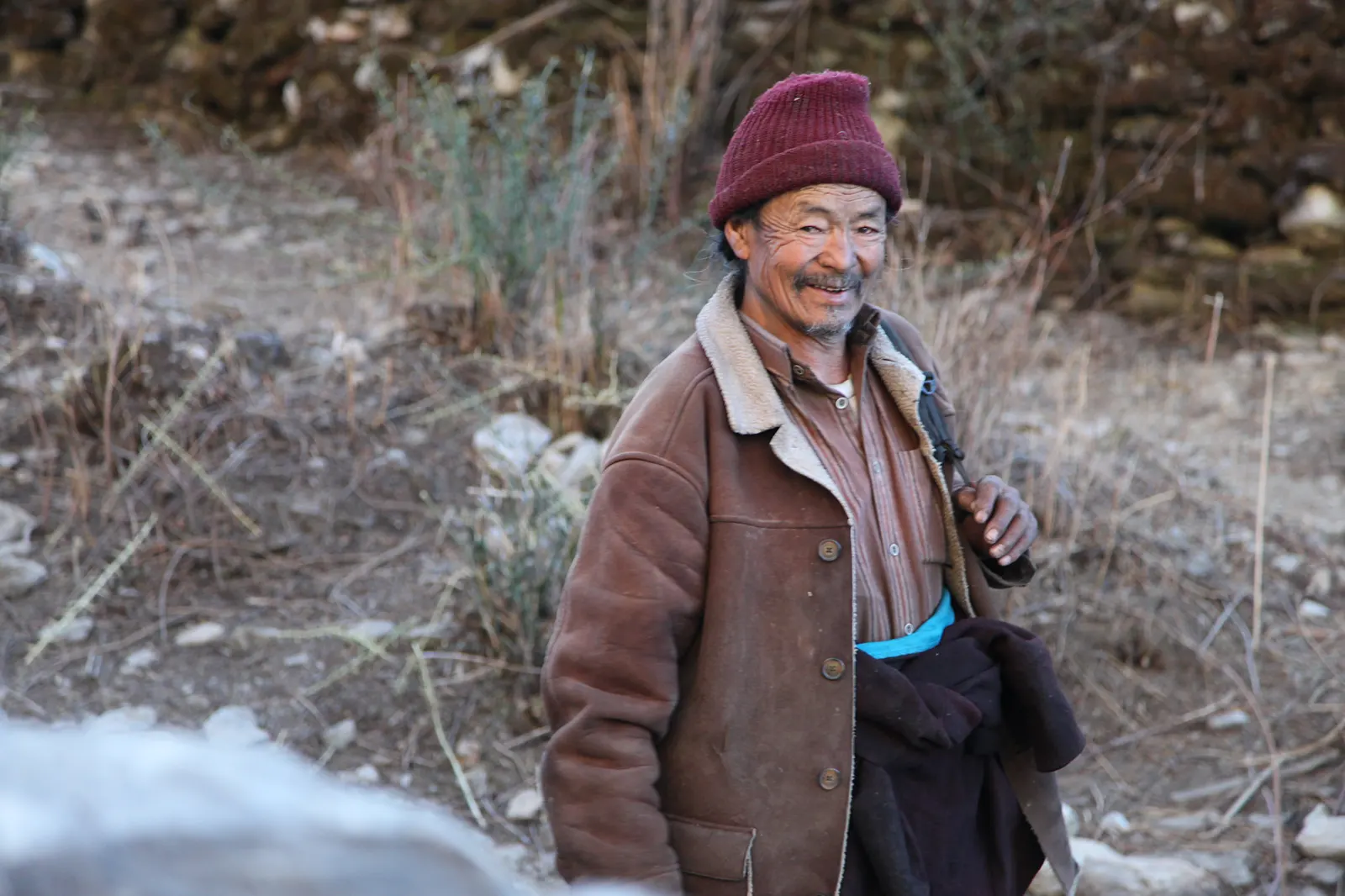
Buddhism holds an important place in the hearts of people in Tsum Valley. They honor and worship Buddha, Guru Rinpoche (Padmasambhava), and several bodhisattvas. They display prayer flags, Khata, or mani walls and light butter lamps in monasteries and believe in the reincarnation of lamas. The people follow various rituals and festivals against evil spirits but do not practice animal sacrifice to please their deities.
Believes and Rituals:
The people of Tsum Valley believe in reincarnation, meaning that birth and death are viewed as cyclic events rather than absolute endpoints. The arrival of a new child is celebrated as a social occasion that brings friends and family together, with the older members of the household taking care of the newborn.
At the same time, the adults carry on with their work. In Tsum Valley, winter is the preferred season for weddings since there is ample time for celebration. While older people traditionally arranged marriages for young people, the youth have started choosing their partners.
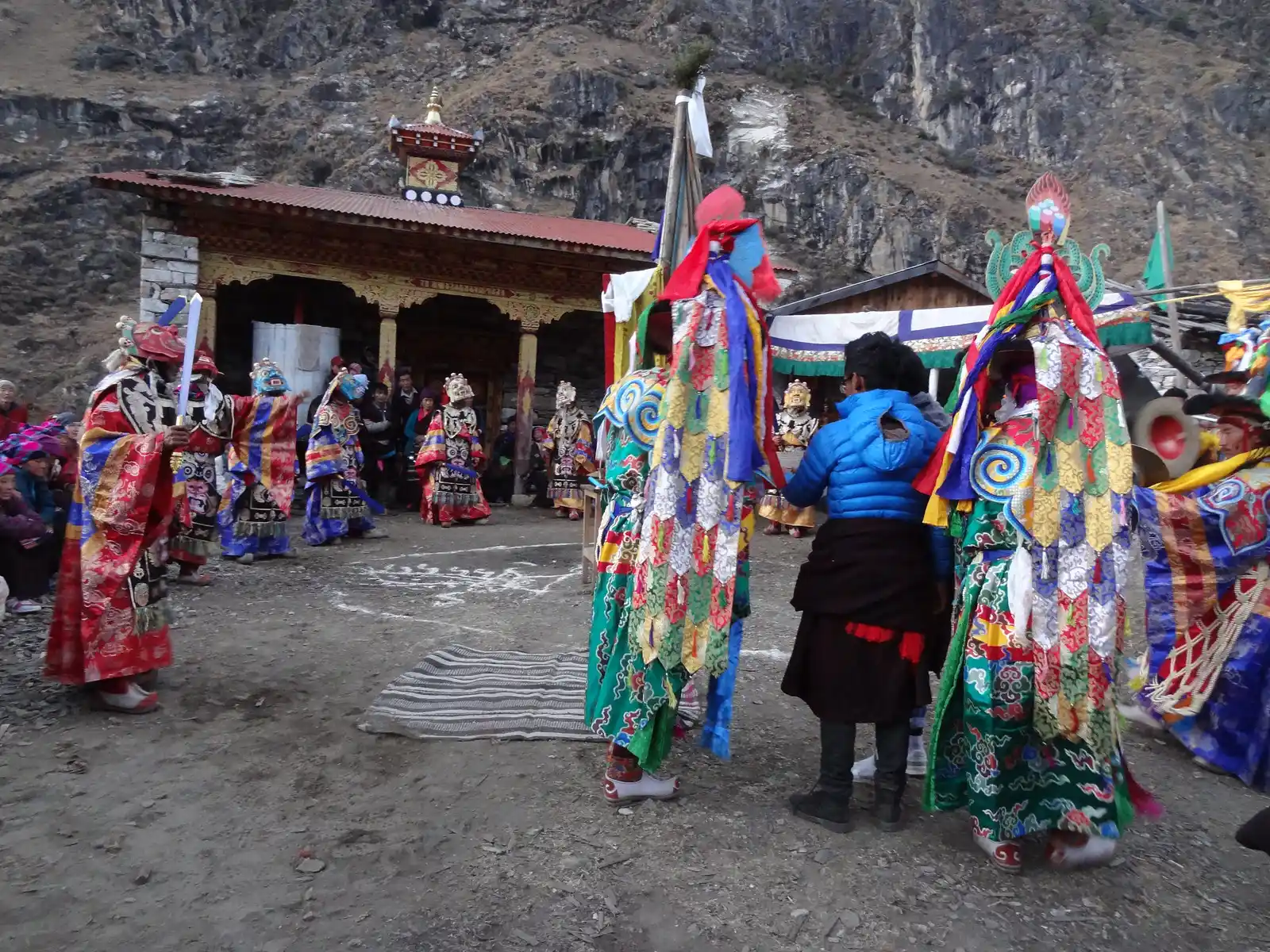
The funeral customs of Tsum Valley are fascinating. When someone dies, their body is left untouched for several days until a Lama visits. The type of burial is then determined by the astrological chart of the deceased person, with the options being cremation, ground burial, water burial, or sky burial.
Festivals:
Tsumbas, the inhabitants of Tsum Valley, are known for their joyous nature and vibrant celebration of festivals and rituals. These festivals are a means of making merry and help preserve age-old customs and traditions. The most important festival in Tsum Valley is Lhosar, which marks the beginning of the New Year. However, the Tsumbas of Lower Tsum Valley celebrates it earlier than those in Upper Tsum.
Dhaching, also known as the horse riding festival, is another major festival celebrated in December/January. Men participate in horse racing while women sing and dance in the evening. Saka Dawa is another important festival, where rituals are performed at local monasteries and nunneries, and people observe a day-long fast.
To explore Tsum Valley, trekkers can start from Arughat in the Gorkha district and follow the Manaslu Circuit route for the first few days. The trek can be extended by including the Manaslu Circuit or linked with the Annapurna Conservation Area before concluding at Besi Sahar in Lamjung.
Why Trek to Tsum Valley
Tsum Valley is an undiscovered destination in Nepal that provides an unparalleled and authentic experience to travelers who want to explore off the beaten track. It is a pristine environment that attracts adventure seekers, nature enthusiasts, and culture lovers to witness the untouched beauty of the Himalayan landscape. Trekking to Tsum Valley is an unforgettable experience that allows travelers to immerse themselves in the local way of life and gain an understanding of the rich cultural heritage of the Tsumba people.
The valley is a natural wonderland, offering stunning mountain peaks, glaciers, waterfalls, hot springs, and crystal clear rivers among Nepal’s most beautiful. The trekking route takes visitors through remote villages, hidden monasteries, and ancient caves, where they can witness the rich cultural traditions of the Tsumba people. Traditional festivals, rituals, delicious local cuisine, and warm hospitality provide an authentic glimpse into its residents’ unique way of life.
Moreover, trekking to Tsum Valley is a perfect opportunity to escape the chaos of modern life and embrace the peaceful environment of the Himalayas. The valley is highly remote, and modernization has not yet reached it. Therefore, visitors can experience a sense of tranquility and serenity that is hard to find elsewhere. With its awe-inspiring natural beauty, unique cultural heritage, and peaceful environment, Tsum Valley is an unmissable destination for anyone who wants to experience the true essence of Nepal.
Things to know before the Tsum Valley Trek
Trekking to Tsum Valley provides a one-of-a-kind experience with stunning mountain views and a chance to discover a rich cultural heritage. Nevertheless, before embarking on this adventure, important factors must be remembered.
To begin with, Tsum Valley is a remote area that requires a special permit. Before entering the valley, visitors must obtain a Restricted Area Permit (RAP) and a Manaslu Conservation Area Permit (MCAP). It is recommended that you seek the help of a local trekking agency or guide who can assist with obtaining the necessary permits and transportation and accommodation arrangements.
Secondly, Tsum Valley is situated at high altitudes, with some parts of the trek reaching over 5000 meters. It is critical to prepare both physically and mentally for the trek, and visitors should consider acclimatization by spending a few days at lower altitudes before beginning the trek. Additionally, warm clothing, high-quality trekking boots, and other equipment, such as sleeping bags and poles, should be packed.
Lastly, visitors to Tsum Valley should honor the local culture and traditions. Tsum Valley is a holy place for many Buddhists, and visitors should dress modestly and behave respectfully in monasteries and other religious sites. Visitors should also avoid littering and follow appropriate waste disposal practices since the region is environmentally delicate. Adhering to these guidelines gives visitors a memorable and responsible trekking experience in Tsum Valley.
Secret Facts of Tsum Valley
Tsum Valley is a place of great intrigue and uniqueness. One of its most fascinating features is its association with the renowned Buddhist saint Milarepa. Legend has it that Milarepa meditated in the mountain caves of Tsum, attracting Buddhists from all over the world who now visit the valley as a pilgrimage site.
Tsum Valley’s isolation from the modern world is another fascinating aspect of the area. Due to its remote location, the valley remains one of Nepal’s most preserved and untouched areas. The local people have successfully maintained their traditional way of life, culture, and customs, adding to the valley’s charm and uniqueness.
Furthermore, Tsum Valley is known for its distinctive dialect and language. The Thumbs, the primary inhabitants of the valley, speak a dialect with Tibetan roots, making their culture even more mysterious and captivating to outsiders who explore Tsum Valley.
Annapurna Base Camp Trek Itinerary: 14 Days Itinerary
Annapurna Base Camp Trek Itinerary (Outline)
Here is the summary of the Annapurna Base camp Trek Distance and approximate hiking time:
Day 1: Arrival in Kathmandu
Overnight at Kathmandu
Day 2: Drive from Kathmandu to Pokhara
Distance Traveled: 210 km
Maximum Elevation: 1345 meters
Overnight at Pokhara
Day 3: Drive to Nayapul and Trek to Hile
Max Elevation: 1,495m
Distance Travelled on Bus: 42 km
Distance Travelled by Walking: 12 km
Overnight at a local teahouse in Hile
Day 4: Trek to Ghorepani
Max Elevation: 2840 m
Distance Travelled Walking: 10.5 km
Overnight at a local teahouse in Ghorepani
Day 5: Hike to Poon Hill and trek to Tadapani
Max Elevation: 3210 meters
Distance to Poon Hill: 1 km
Distance to Tadapani: 9 km
Overnight at a local teahouse in Tadapani tea houses
Day 6: Trek to Sinuwa Village
Max Elevation: 2840 m
Distance Travelled Walking: 13 km
Overnight at a local teahouse in Sinuwa
Day 7: Trek to the Himalayas
Max Elevation: 2,920m
Distance Travelled Walking: 9 km
Overnight at a local teahouse in the Himalayas
Day 8: Trek to Annapurna Base Camp
Max Elevation: 4,130m
Walking Distance: 13km
Overnight at a local teahouse in Annapurna Base Camp
Day 9: Trek to Bamboo Village
Bamboo Elevation: 4,130m
Walking Distance: 16 km
Overnight at a local teahouse in Bamboo
Day 10: Bamboo to Jhinu Dada
Max Elevation: 2345 m
Walking Distance: 12 km
Overnight at a local teahouse in Jhinu Danda
Day 11: Trek to Pothana
Walking Distance: 13 km
Overnight at a local teahouse in Pothana
Day 12: Trek to Phedi and down to Pokhara
Walking Distance: 9 km
Overnight in Pokhara
Day 13: Drive back to Kathmandu
Distance traveled: 210 km
Overnight in Kathmandu
Day 14: Final Departure
Drive to the Tribhuvan International Airport
Day 01: Arrival at Tribhuvan International Airport, Kathmandu
Upon your arrival, the Peregrine Treks and Expedition representative will receive and welcome you at Tribhuvan International Airport and accommodate you at the respective hotel via a private vehicle.
Day 02: Drive to Pokhara, a 6 to 7 hours drive
After breakfast, one of our staff will pick you up from the hotel and transfer you to the tourist bus. Driving from Kathmandu will take around 6-7 hours to reach Pokhara. On the way to Pokhara, you can enjoy the fantastic scenic view of the terraced rice field, beautiful landscape, and spectacular panoramic view of Ganesh Himal, Mt. Manaslu, and Lamjung Himal.
Day 03: Drive to Nayapul, a 1 to 1.5 hours drive, and trek to Hile, 3 to 4 hours of trek
On the third day, you will drive to Nayapool, which takes around one and a half hours from Pokhara. After reaching Nayapool, we will start our trek to Hile. After a 15-minute walk from Nayapool along the Modi River, we will reach the village of Birethanti (1,015 m).
We will walk through the village and continue along the northern side of Bhurungdi Khola. After a steady ascent, we will finally reach the village of Hile (1,495m). It is a pretty easy walk today, which takes around 3 to 4 hours.
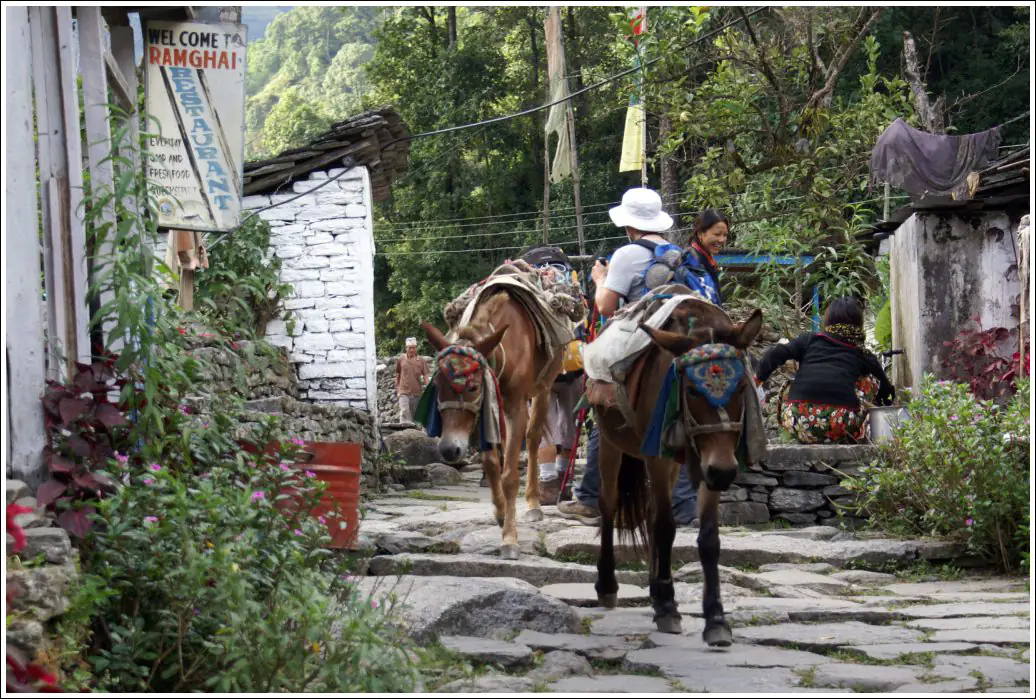
Day 04: Trek to Ghorepani, 5 to 6 hours of trek
After breakfast, our trek begins with a long and steep climb on rock staircases to Ulleri, a large Magar village at 2070m. From Ulleri, you can have astonishing views of Annapurna South and Hiunchuli. The trails mildly ascend from Ulleri through oak and rhododendrons forest, which leads us to Banthanti (2,250m).
Then, the trail continues toward Nangethanti (2,460m). From Nangethanti, it takes around one hour to reach the beautiful village of Ghorepani (2840m). Ghorepani is a beautiful village that offers excellent views of Annapurna and Dhaulagiri.
Today’s walk of the ABC trek was more challenging than the previous day as there were many uphills and downhills. You must cross several suspension bridges and walk through gorges and rainforests.
Day 05: Hike up to Poon Hill and trek to Tadapani, 7 hours of trek
We will wake early, around 4 AM, and hike towards Poon Hill (3,210 m). Poon Hill is a vantage point that offers a jaw-dropping sunrise view over the majestic Himalayas. From Poon Hill, you can witness the picturesque views of Annapurna South (7,219m), Annapurna I (8,091m), Annapurna II (7,937m), Annapurna III (7,855m), Annapurna IV (7,525m), Lamjung Himal (6,931m) and other peaks in Dhaulagiri and the Annapurna mountain ranges.
After one hour of admiring the beauty of Poonhill, we will descend back to Ghorepani, have breakfast, and continue our walk toward Tadapani. The trail takes us through a thick forest of pines and rhododendrons. We then climb along the ridge to reach Deurali (2,960 m) and descend to the village of Tadapani (2,610m).
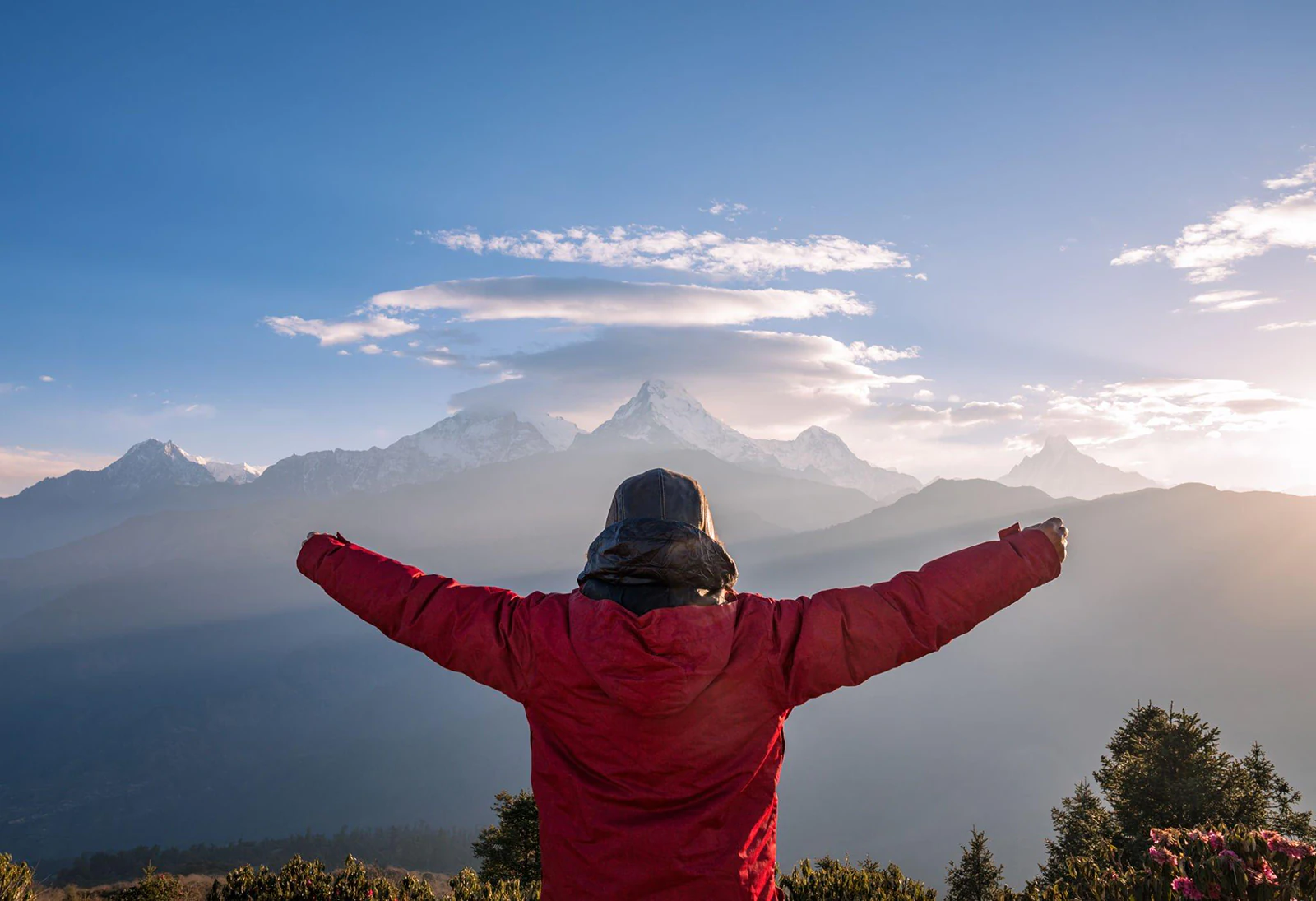
Day 06: Trek to Sinuwa Village, 6 to 7 hours
Today, we woke up early to see the beautiful view of Machhapuchhre. After having our breakfast, we continue to move toward the base camp. From Tadapani, the trail divides into Ghandruk and Chhomrong. We skipped the trail to Ghandruk and continued toward Chhomrong. The trail will descend through lush, dense forest to the suspension bridge across the Kimrong River.
After crossing the bridge, the trail gently ascended to Taulung. From Taulung, you will walk through a steep descent to reach a significant Gurung village in the region, Chhomrong (2,140 m).
From Chhomrong, you will hike down following the stone steps to the bridge across the Chhomrong River. After we cross the bridge, it is again a steep climb to reach Sinuwa Village (2,360m) finally.
Day 07: Trek to the Himalayas, 6 to 7 hours
On the seventh day of our trek, we continue our trek to the Himalayas after breakfast. Today, the walk begins with a steep climb through the rhododendron, oak, and bamboo forest, leading us to the village of Kuldhigar. From Kuldhigar, we will hike down the stone steps to Bamboo Village. The trail from Kuldhigar to Bamboo is a steep descent that is very slippery, so you need to be careful.
After reaching Bamboo, continue towards Dovan and cross the village to reach today’s destination at Himalaya, finally situated at 2,920m above sea level (also known as Himalayan Hotel).
Day 08: Trek to Annapurna Base Camp, 7 hours of trek
Today is when you finally reach the leading destination of the trek, Annapurna Base Camp. We will start our day with an uphill walk through the thick, dense forest towards Hinko Cave and then to Deurali. From Deurali, we will first hike toward Machhapuchhre Base Camp (MBC), quickly crossing the avalanche site.
MBC isn’t a base camp since Mt Machapuchare is forbidden for climbing. The trail is pretty easy today. There is no steep walk; the trail widens, and you will start seeing the beautiful mountains.
Upon reaching the MBC, you will walk north toward the Annapurna Sanctuary. As you walk, you will witness the high lateral moraine of the South Annapurna glacier. After a 2-hour walk from MBC, enjoying the spectacular views of the Himalayan vistas, you will finally reach the Annapurna Base Camp at 4130 meters.
You will have the closest and most fantastic view of the Mardi Himal, Machhapuchhre, Annapurna III, Gangapurna, Singu Chuli, Khangsar Kang Annapurna I, Hiunchuli, and the Annapurna South from Annapurna Base Camp.
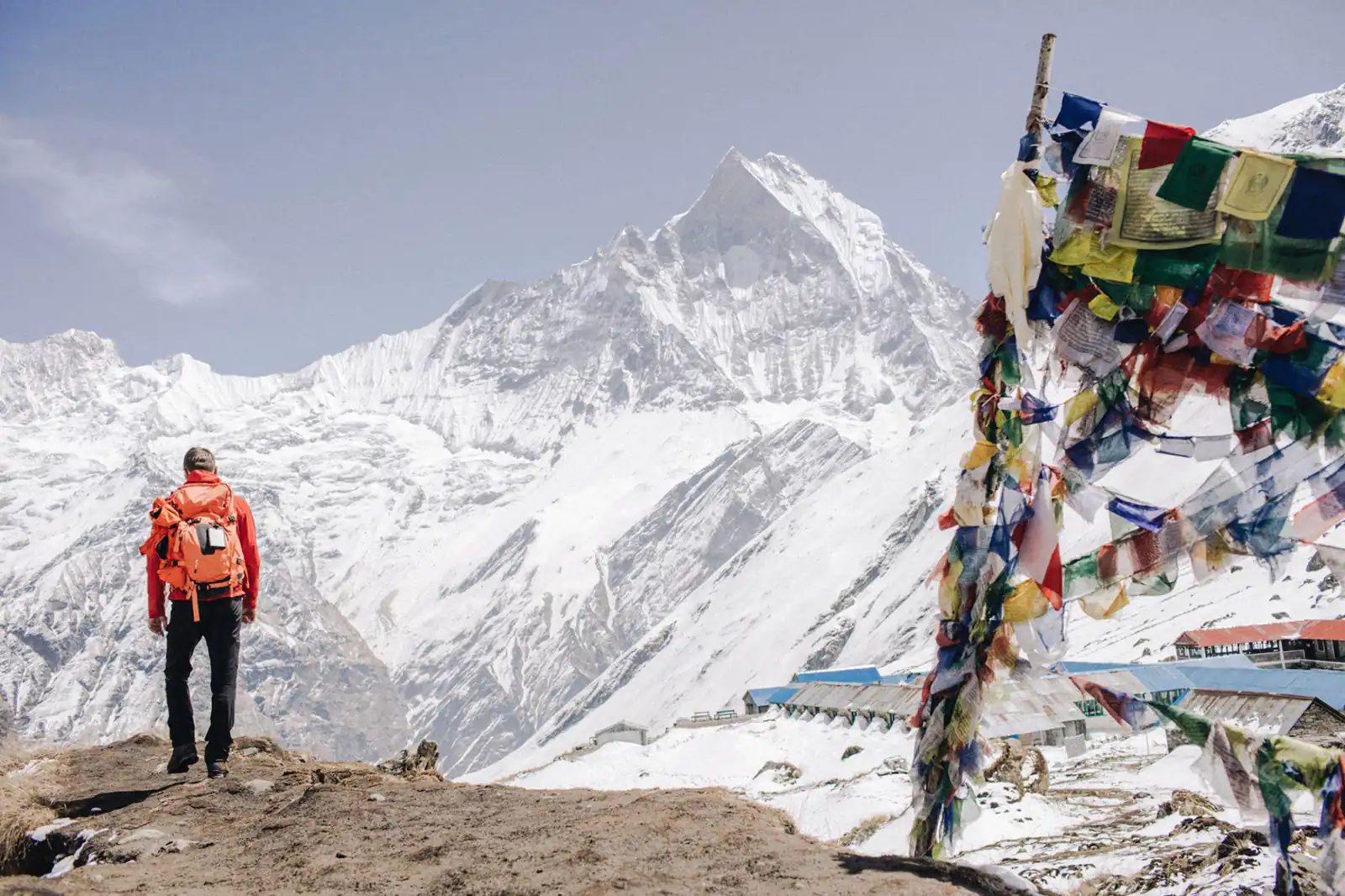
Day 09: Trek to Bamboo, 6 to 7 hours of trek
Today, we will wake up early and hike to the viewpoint to enjoy the sunrise view over the Annapurna range. As the first ray of the sun hits the mountain peaks, it will truly captivate your heart and soul.
After taking in the beauty of Annapurna, we will get back to our hotel, have our breakfast, and make our way back to Bamboo, Bamboog, the majestic mountains behind. We hike past the MBC, Deurali, and Dovan. Then, we will walk through the oak, bamboo, and Bambooododendron forests and descend to Bamboo.
Day 10: Trek to Jhinu Danda, 5 to 6 hours of trek
After breakfast, we first hike to Kuldighar and descend to the Chhomrong River, crossing Sinuwa and Tilche. After crossing the suspension bridge over the Chhomrong River, we will hike up to Chhomrong village. Then we will walk downhill for around 40 minutes past Taulung to finally rich Jhinu Danda.
Upon reaching Jhinu, you will rest at the teahouse and hike down to the natural hot spring, situated right on the riverbank of Modi Khola. Take a dip into the hot spring and relax your tired muscles. Feel the sense of achievement as you have completed the ABC trek. After the relaxing dip, you will hike back to the lodge.
Day 11: Trek to Pothana, 4 to 5 hours of trek
After the refreshment at the natural hot spring in Jhinu Danda, we will head towards Pothana. We will cross a few suspension bridges and many waterfalls along the trail. We will walk past the Samrung village and cross the bridge over the Modi River. After crossing the suspension bridge, we will hike up to Landruk.
From Landruk, the trail drops down and takes you to the scenic village of Pothana. You can explore the traditional village or watch the sunset on the mounts.
Day 12: Trek down to Phedi and back to Pokhara
After having our last breakfast in the Annapurna region, we will hike toward Phedi. Along the trail, we can spot beautiful waterfalls. Today’s walk is pretty easy, as most trails are downhill. From Pothana, we will hike down to Dhampus to finally reach Phedi. Along the trail, the view of Dhaulagiri and Machhapuchhre is simply magnificent.
After reaching Phedi, we will catch a local bus to drive us back to Pokhara. It will take us around 2 hours to reach Pokhara. We can freshen up in our hotel and then start exploring the beautiful city of Pokhara. As you leave towering giants and trek down to peaceful communities, this day can be named a ‘Trek from Prodigious Mountains to Quaint Villages.’
Day 13: Drive back to Kathmandu, a 6-hour drive
After an epic journey in the Annapurna region, you will drive back to Kathmandu via Prithvi Highway, enjoying the natural scenic beauty. After 6 hours of driving, we will be back in Kathmandu.
As we arrive in Kathmandu, you will be escorted to your hotel, and the rest of the day is yours. You can explore the colorful markets of Thamel or visit UNESCO sites. Furthermore, you can experience the rich culture that the people of the valley share. Make the most of your last light in Nepal.
Day 14: Final Departure
The trip concludes today. Our airport representative will drop you off via private vehicle at the Kathmandu International Airport upon your departure from Nepal.
ABC Trek Package from Peregrines
We provide various packages for the Annapurna Base Camp Trek, allowing you to customize them according to your preferences. Choose from budget, standard, and deluxe options, each offering distinct features.
If you are looking into different trek points or routes of the Annapurna region, check out our Annapurna circuit trek package. If trekking isn’t your preferred way to explore, but you still wish to witness the beauty of the Annapurna region, we have an exciting alternative for you. Book a thrilling Nepal helicopter tour with us!
Benefits of traveling with Peregrine Treks
When you decide to set on trekking Annapurna Base Camp with us, you unlock a wealth of advantages such as:
- Exclusively secured accommodations at esteemed hotels in Pokhara and Kathmandu, including breakfast, immaculate rooms, and en-suite bathrooms
- Accommodate you in our most exquisite and awe-inspiring establishments throughout the ABC trek
Well-tailored to your needs with a carefully crafted schedule and financial parameters - Ample opportunity for all trekkers to capture photographs and appreciate the natural beauty of Annapurna Base Camp & Sanctuary
- Assure that our group sizes are kept small so you can get to know the other travelers and form meaningful connections with those around you.
- Arrange customizable altitude trekking at short notice based on your special requests or unexpected changes in your plans.
- An experienced guide who takes care of your physical fitness and comfort during the entire trek and assistant guide for larger groups
Conclusion
The itinerary mentioned for 14 days of trekking at Annapurna Base Camp is just a general guideline. The Annapurna Base Camp Trek itinerary arrangements can be customized according to your requirements. Furthermore, if you have any further questions or queries, please get in touch with us to learn more about the Annapurna Sanctuary Trek itinerary. For more trek info and travel tips, consider looking into these articles:
Best Time for Annapurna Base Camp Trek
How to prepare for Annapurna Base Camp Trek
Annapurna Base Camp Trek in December
Annapurna Base Camp Trek Difficulty
Annapurna Base Camp Trek FAQs
How much does ABC Trek cost?
Hiking around Kathmandu Valley
Option 1: Shivapuri Peak by way of Vishnudwara
Shivapuri Peak summit via Vishnudwara is another alternative for hiking around Kathmandu Valley. Head left from the signboard area (the sign indicates 6 km, or 3.7 mi, to Vishnudwara), cross a bridge and follow comprehensive stone steps. After about one to one and a half hours, reach a built-up tap marking the origin of the Vishnumati River. Unfortunately, the surrounding area is often littered with refuse from picnickers. Five minutes beyond is a trail junction.
To the left is a trail that descends steeply towards a road that can be followed west to Kakani (5 to 6 hours away through a jungle without facilities). Follow the path to the right to ascend for 30-45 more minutes before the steps finally end and the single path track continues steeply. Eventually, pass below the remains of an old army post and hermitage of the late Shivapuri Baba and the summit beyond in 15 minutes from the end of the stone steps.
Option 2: Shivapuri Peak bypassing Nagi Gompa
Head up to the dirt road from the signboard at the gate to the park. Following this road, in 20-25 minutes, a view of the valley opens up, and just over five minutes beyond, a set of stone stairs leads off to the left (north) before immediately ascending to the right (east) for a steep climb to the summit (5.5 km away according to a sign, about 3.4 mi). There is a roofed shelter a minute from leaving the road. The stairs end in 30-35 minutes, and a single dirt trail begins—the trail ties in with the broader trail from Nagi Gompa in 15 to 20 more minutes. Head left, and in less than 30 minutes, reach Baghdwara (to continue from Baghdwara, and then see the section immediately below).
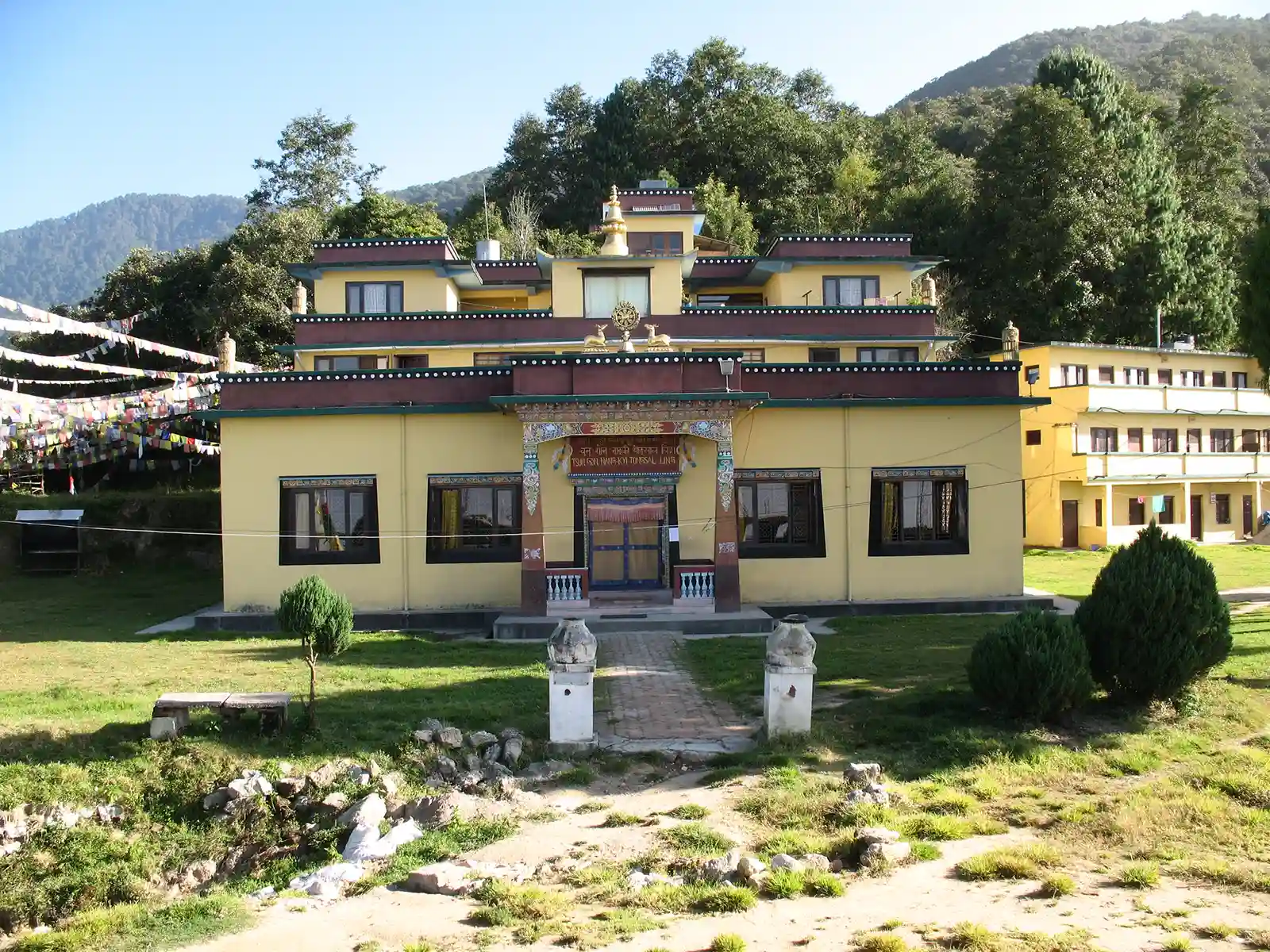
Option 3: Shivapuri Peak by the way to Nagi Gompa
To travel by way of Nagi Gompa, rather than ascend the stone steps to the left of the road described immediately above, keep along the road and, in 15 more minutes, ascend another set of stone steps that lead up to the left (the vehicle road continues to Sundarijal, about 9.5 km or 6 miles away). A lower shrine hall is reached in 10 minutes.
Nagi Gompa is a nunnery of the Kagyupa and Nyingmapa lineages of Tibetan Buddhism with 100-110 residents, mostly Tamang, Tibetan, and Newari. The convent has a small shop and six guest rooms should you need a stopover. Spiritual pilgrims often book the rooms, and more rooms are under construction. To the right of the upper shrine room and small clinic, pass through the compound’s gate and follow the prayer flag-lined trail as it climbs through the jungle on a single track. Stay on the broadest path and reach Baghdwara in one and a half hours. Nearby are two cave shelters, sometimes occupied by hermits. Baghdwara is considered to be the source of the sacred Bagmati River. There are three built-up spouts and a nail pond with a seated Shiva holding a trident. Two chorten and several lingams have been put up in the area.
A few minutes more along the trail is the ashram of two yogis and a small, usually unmanned combat. One yogi, Todoke Baba, is from India and has been here for 19 years. The name is Todke refers to a hallowed out at the base of a tree. This baba used to stay in such a place just above the way to the summit and hence the name. Another yogi goes by the name Pashupati Baba. He has been here for eight years and hails from the Godawari area of Kathmandu Valley.
The path onward splits at the ashram. To the right bypasses Shivapuri Peak and heads to Chisapani, a village on the way to Helambu. The path to the left ascends to Shivapuri Peak, and a nearby sign indicates 1 km (0.6 miles). To continue to the summit, follow the path up, and in a minute, it branches into three trails. Stay with the middle path that ascends steeply, and in less than 10 minutes, every two hermitages built into space the base of trees where Todke Baba ice stayed.
Continue to the summit in about 10 minutes from the tree hermitages. To the west of the summit, the remains of an old army post d hermitage of the late Shivapuri Baba. The army post was abandoned ring the 10-year civil war (1996-06) because of the threat of Maoist attack and lack of nearby water source. Shivpuri Baba stayed here for many years and died in 1963 at 137.
Alternate approach Boudhanath Stupa/Kapan Gumba to Nagi Gompa
From Boudhanath Stupa, start from Ram Hiti Chowk (intersection) along the road 10 minutes north of the stupa. From this intersection, follow the road north for about 25 minutes to reach Kopan Chowk (also known as Krishna Chowk), near a small shrine. This intersection is just above Kopan Bus Park and below the Kopan Gomba monastery. Follow the road to the right (northeast) from this intersection, passing a secondary school and below Kopan Gomba and Rigpe Dorje Gompa.
In 10 minutes, come to a junction of several roads near the gate of a police training center. Follow the road that leads to the northeast, and after 100 yards/meters from the police gate and just beyond a building, head left along a single track that passes to the left (northwest) side below Pulahari Gomba. In 10 minutes, reach a road near a secondary school in Jagadol Bhanjyang (to the right, this road leads to a gate to Pulahari Gomba).
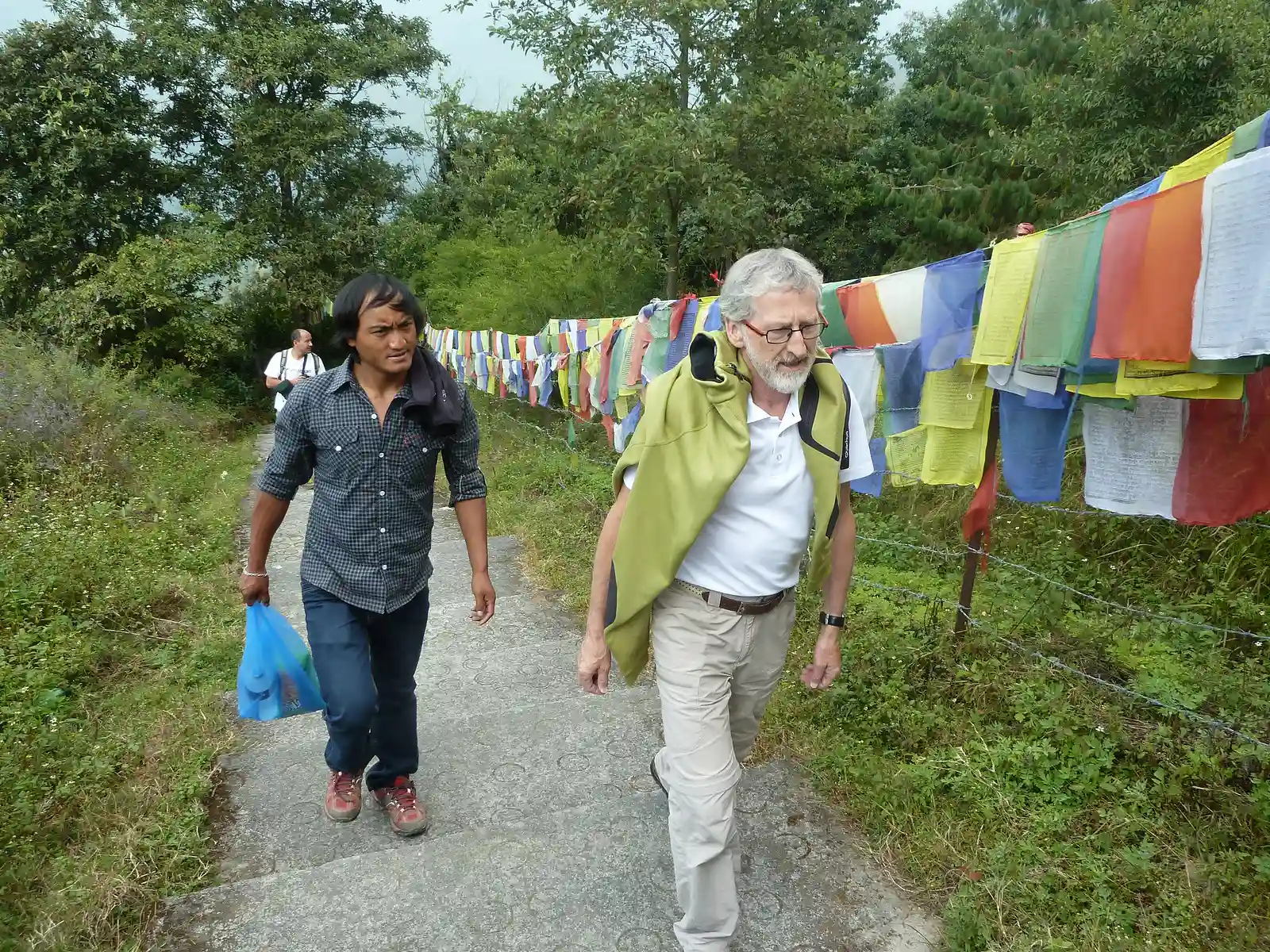
Stay left and immediately turn left from the paved road along a dirt road and reach a pipal tree with a small shrine dedicated to Krishna at a junction. Do not follow the roads but ascend the pine tree-covered hill to the north (northeast). The first section is steep and crisscrossed with pasturing trails; the route then contours while gradually ascending along the ridgeline toward the north through a peaceful pine forest. Keep to the most comprehensive trail and enjoy sensational views along the way.
Reach a significant open ground (5577 feet, 1700 m) within an hour with outstanding, open views of Kathmandu Valley to the south and southwest. Nagi Gomba can be seen above to the north and Tare Bhir Village to the northeast. Stay to the right of the ridge and continue on its east side in 5 minutes, pass a large gate on the left and keep gradually ascending on the broad path, and in less than two more minutes, branch sharply back to the left and ascend to a pair of houses (to the right continues to Tare Bhir Village) and continue to the right (north), climb steeply along the ridgeline.
Pass a small monastery affiliated with Nagi Gompa and just above reach a road in 15 minutes from the pair of houses. Head left, north (to the suitable heads to an army guard post and Tare Bhir in 10 minutes). Contour along the road, and in a few minutes, its branches. Follow the road branching to the right up to Nagi Gomba (6528 feet, 1990 m) in 10 minutes.
Phulchowki Peak – Best Hiking around Kathmandu Valley
This route leads to the highest summit in the valley, Phulchowki, meaning “Flower Fortress.” The peak is so named for the abundance of flowers that fill the ridge top near the army post in the summertime. The first section visits villages with sensational views of the mid-hills and Kathmandu Valley. Further along, the trail becomes isolated and passes through dense forest with few facilities, and although rare, attacks have been reported. Use caution and do not travel to this area alone. Group Hiking around Kathmandu Valley is highly recommended.
Getting to the Trailhead
The starting point of this hike is SURYA BINAYAK (a reference to the sun, Surya, and the Hindu god Ganesha, aka Binayak) near Bhaktapur on the Arniko Highway. Buses to Bhaktapur leave from City Bus Park (Old Bus Park and Ratna Bus Park) and nearby Bhaktapur Bus Park in central Kathmandu. You will need to reach Surya Binayak, the town adjacent to Bhaktapur along the Arinko Highway, the highway to the border with Tibet. Specifically, begin from Surya Binayak Chowk (intersection). At this intersection, follow the side road south away from the highway towards Surya Binayak Temple (also known as Ganesh), dedicated to the Hindu deity Ganesha. Reach the steps up to the temple within fifteen minutes. The main temple is a short climb from the gate, and Aamaasthan (Mother’s Temple) is a few minutes higher.
From the main Ganesha Temple area, continue from the south gate to descend to a road in 2 minutes. Head right for a minute and then keep correct again. In just over five minutes, reach a small shrine at a branch of the road. Ascend to the right and the road branches again after about 35 minutes. This time stay left (south), and within ten more minutes, a road to the right branches to the first houses of Ghyampedada. It takes less than 10 minutes to pass through the hamlet with a splendid view of Kathmandu Valley to the west.
Continue heading south, and within two minutes, the wide trail branches. Stay left, and within 2 to 3 more minutes, avoid a trail that branches to head down to the east but stay on the main trail. Just beyond, take the trail to the right (west), away from the main trail. Ascend steeply for several minutes to tie in with a road above and follow it left.
Reach Rankikot (6345 feet, 1934 m) in about ten more minutes. Be advised that the route passes through an unpopulated area, and theft has been reported. Do not travel alone. Stay to the right (west) for Lakuri Bhanjyang and the most direct route to Phulchowki. In a few minutes, the road ends at Bhag Bhairab, a rock shrine said to resemble a tiger. Take the upper two trails to the left that pass below Bhag Bhairab and then follow along with the ridgeline with magnificent views of the Kathmandu Valley on the right side.
Reach a few houses in a little over 20 minutes, follow the wide trail to the north (north) that descends, and stay left at a branch to a school and a collection of shops and restaurants at Lakuri Bhanjyang in less than 10 minutes.
Sakurai Bhanjyang is at a crossroads. To the right (west), the road descends to buses at Lamatar about One and a half hours (3.4 miles, 5.5 kin) below, with bus service to Kathmandu. To the left (east), the road continues to Panauti, 9.6 miles (15.5 km) away.
Lakuri Bhanjyang to Phulchoki Summit
To continue to the peak, head east for about 100 meters/yards before ascending to the right (southwest), away from the main road along a wide track. Stick to the main trail, and within 10 minutes, pass a set of stairs branching to the right (the stairs ascend to a viewpoint 2 minutes above). In less than five more minutes, the trail branches. Stay right to ascend gradually, contour, and descend to a school at a saddle (6890 feet, 2100 m) in 20-25 minutes. Find the fainter path on the southeast side of the saddle rather than the broader trail that ascends to the east, although both tie in beyond. Reach Champakharka (6844 feet, 2086 m) in just over 10 minutes. From here, cross to the southwest (the road to the right (west) descends to Godawari, and the road to the left (southeast) heads into Nuwakot District).
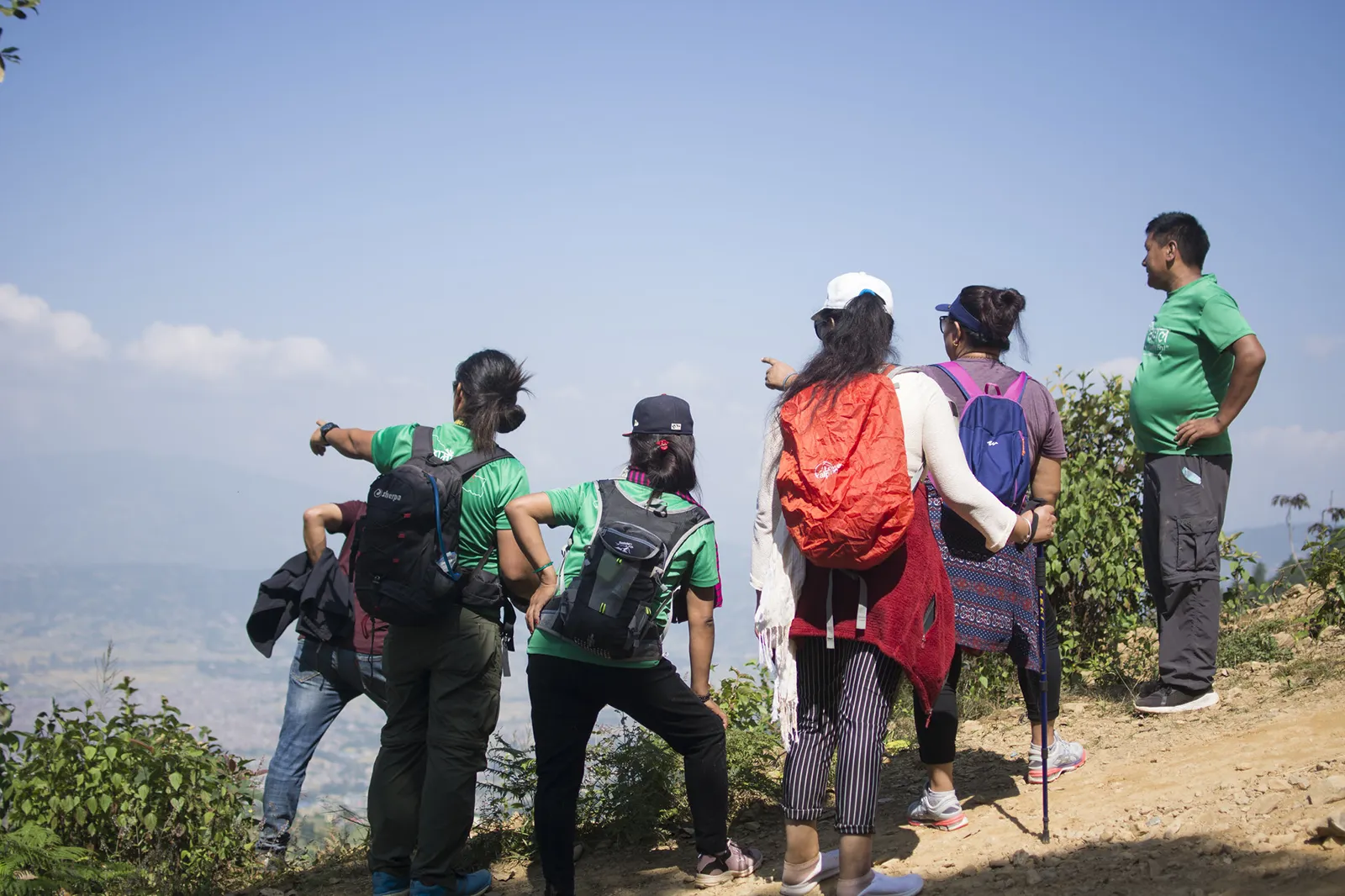
From Chapakharkha to the peak, the trail passes through a dense forest without facilities. Ascend to the southwest, and in 15 minutes, avoid a trail heading down to the left (east). Within ten more minutes, the trail branches. Stay to the right and generally head south and stick to the main trail. In 20-25 more minutes, the trail branches again. Both branches head to the above road, whereas the left branch is the more direct option, albeit steeper. Reach the main roadway to the peak in less than 10 minutes. Head left and followed it to the summit, about One and a half hours or 2.8 miles (4.5 km) away. The summit (9039 feet, 2755 m) has an army post guarding signal towers and a small Hindu shrine, Phulchowki Mai. Views are somewhat acted by the towers, barracks, and boulders at the top.
Godawari lies below and to the northwest of the summit, and transport to Kathmandu can be found there. Follow the road from the top down to the microbus stand just below Saint Xavier’s school. The journey of 8.7 miles (14 km) takes nearly 3 hours with no facilities and few to no water sources along the way until the valley floor.
The Hindu Nau Dhara Temple is just above St. Xavier’s and has a bus staging area. To the east of the bus stand is a paved road to the National Botanical Gardens, a 10-minute walk away. The entry fee is 10 NRS for Nepalese, 25 for SAARC country members, and 100 NRS for Non-SAARC foreigners. Nearby the gardens are the Hindu shrine dedicated to Godawari Kunda. To the west of the bus stand area quarry, and the marble factory. To reach Kathmandu, transfer to two other minivans before City Bus Park. (Old Bus Park or Ratna Bus Park in central Kathmandu).
Best Trekking packages in Nepal – Which one to choose
Other Best Trekking Packages in Nepal
Outside of the three regions outlined above are many places undiscovered by most travelers, including the Manaslu, an up-and-coining destination to rival the adjacent Annapurna region. In lesser-known areas, especially in the mid-hills, few lodges or facilities have been set up strictly for tourists, and some trail sections might be challenging to follow.
Physical comfort along alternative trails might be at a minimum. The rewards are visiting scenic, pristine areas in the heartland of Nepal and meeting hill people, the soul of Nepali culture, in traditional settings.
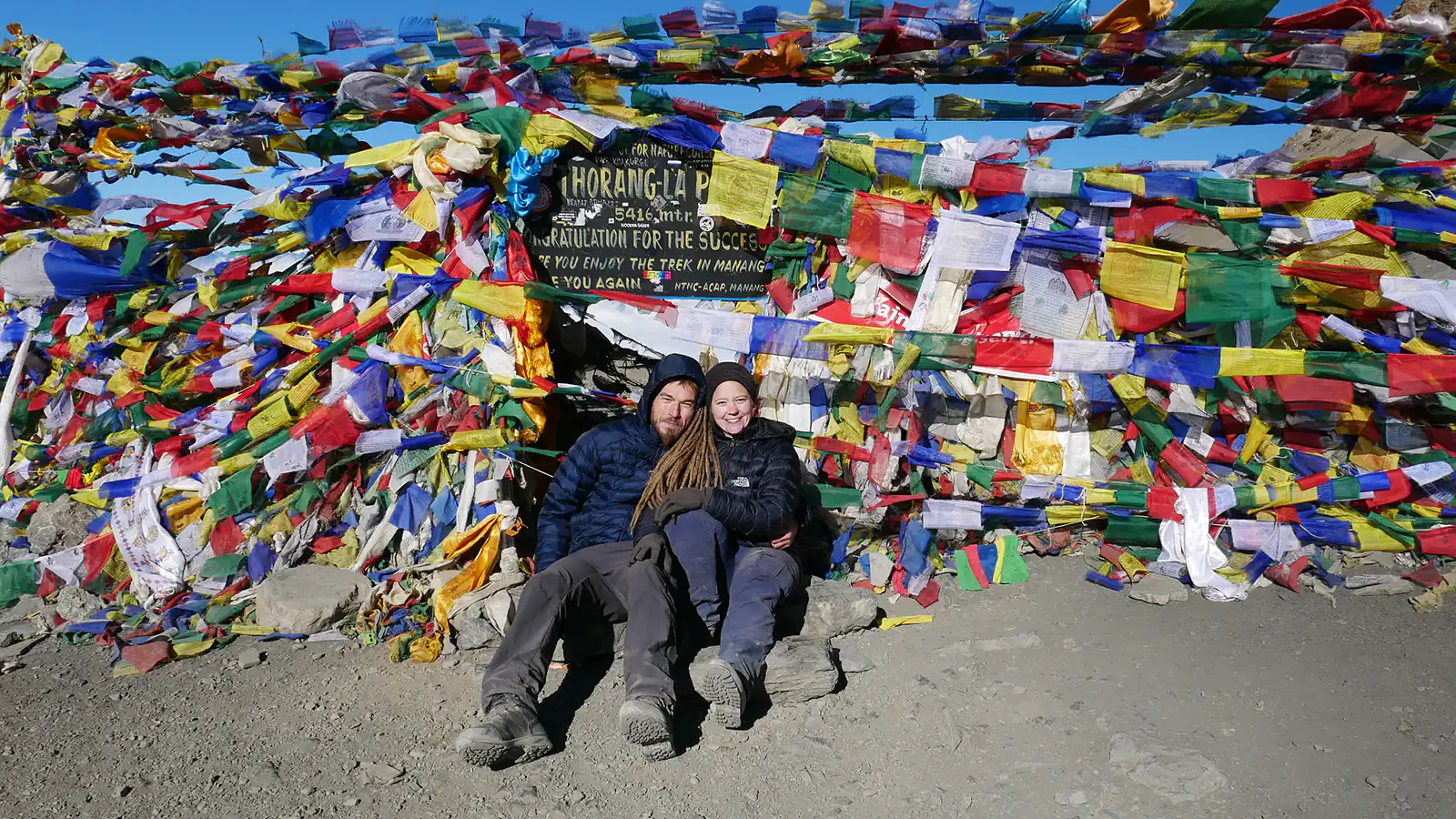
Areas off the beaten path will be largely unaffected by modernization, and the experience will be unforgettable. Trails through these areas are not for everyone. Considerable resilience, a spirit of adventure, and an open mind are needed. It is perhaps best to consider the first trek on a more established tourist trail.
As your experience grows, take on more in-depth journeys. Manaslu Circuit Trek, Nar Phu Valley Trek, and Tsum Valley Trek are the best trekking packages in this area.
Best Trekking Packages in Nepal (Western)
For people interested in hiking trips along the country’s west, remember that there are few facilities for travelers, and even food is sometimes unavailable. Intrepid folk aiming for Jumla (and on to Rara Lake) can reach the destination by a hard-going seasonal road that regularly washes out or by scheduled planes from Kathmandu.
Still, it is easier to connect through airfields in Nepalganj or Surkhet and then fly into Jumla. Travelers might share the plane with heavy bags of rice from the Nepal Food Corporation and U.N. Food Program, as the area is regularly short on food. Upper Dolpo Trek, Lower Dolpo Trek, and Rara Lake Trek are the best trekking packages in Nepal.
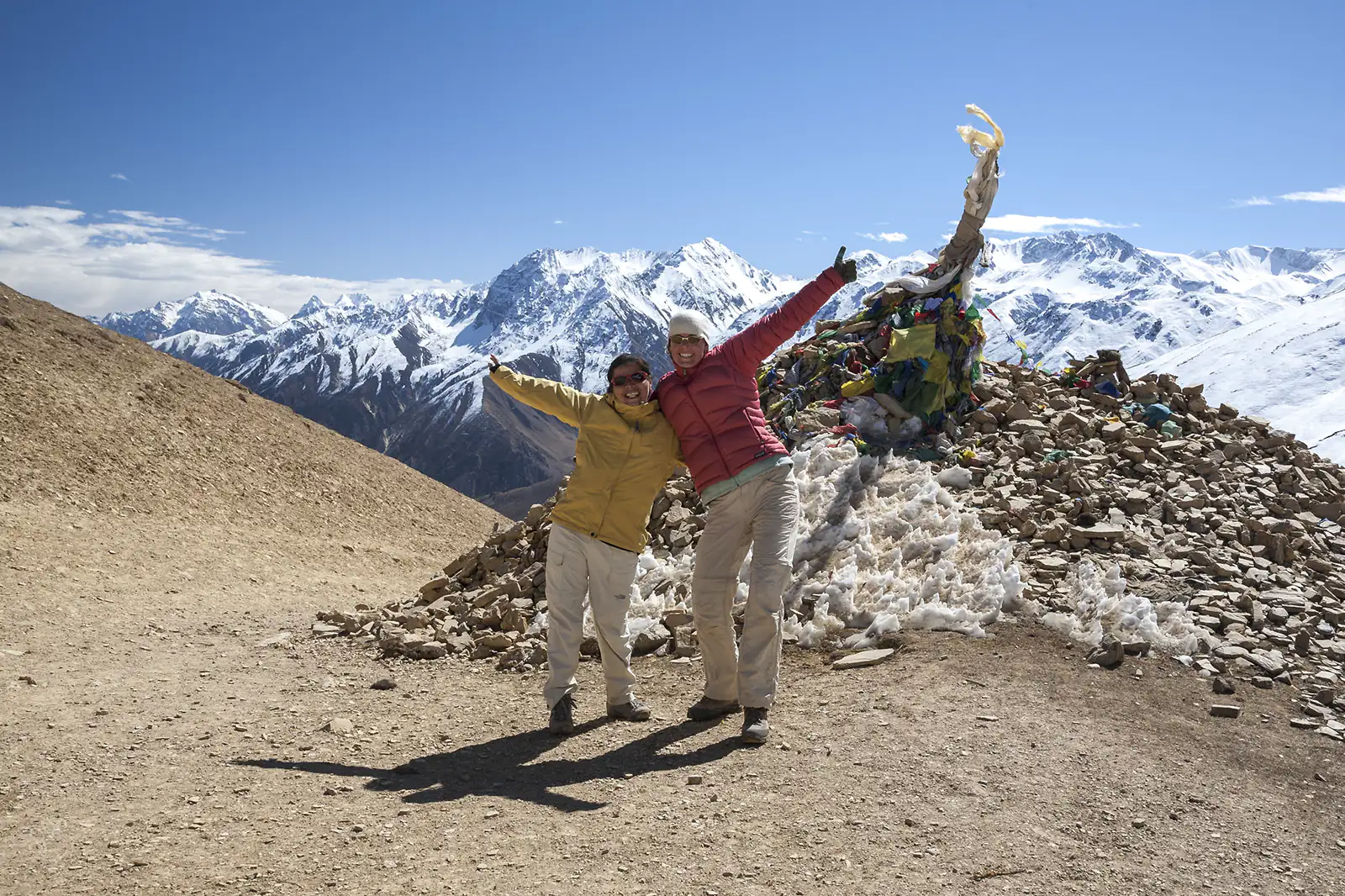
Rara is a three-day trek from the Jumla. An option on the way out is to trek to Kolti airport in Bajura District in three days along a route improved by locals through the U.N.’s food-for-work program. Although flights out of Kolti might be precarious, air service in remote areas can be intermittent.
Scant facilities along the way provide the bare minimum in food and a place to sleep. Rather than fly out from Kolti, an option is to continue south to Khaptad National Park or Sanphebagar in Accham District and meet another airstrip and the roadway. Only 135 trekkers visit the Rara area in 2010 and a mere 5 went to Khaptad.
Nepal Trekking Packages with Peregrine Treks
Peregrine Treks is a dedicated organization that will guide you through the true essence of Nepal’s natural and cultural wonders. Our thoughtfully designed trekking packages will take you on an extraordinary journey through the stunning Himalayas, where you’ll be mesmerized by majestic mountain peaks and breathtaking landscapes.
From the renowned Mount Everest to the serene Annapurna region, our treks cater to adventurers of all levels, providing a safe and enjoyable experience for everyone. Traverse through lush valleys, dense forests, and charming villages, connecting with Nepal’s rich cultural heritage, interacting with friendly locals, and savoring authentic cuisine.
Our experienced guides will lead the way, ensuring you create cherished memories while supporting responsible and sustainable tourism. Nepal Trekking with Peregrine Treks will certainly be a lifetime experience with everlasting memories of snow-capped mountains, beautiful villages, and the warmest hospitality.
Conclusion
These famous treks not only let you enjoy the breathtaking scenery but also connect you with the country’s rich cultural experience. The memories you make and the people you meet will leave a lasting impression on your heart.
So, if you’re looking for a unique and unforgettable journey, consider trekking in Nepal. It’s a chance to experience nature’s wonders and immerse yourself in the beauty of this Himalayan paradise. Your adventure of a lifetime awaits!
